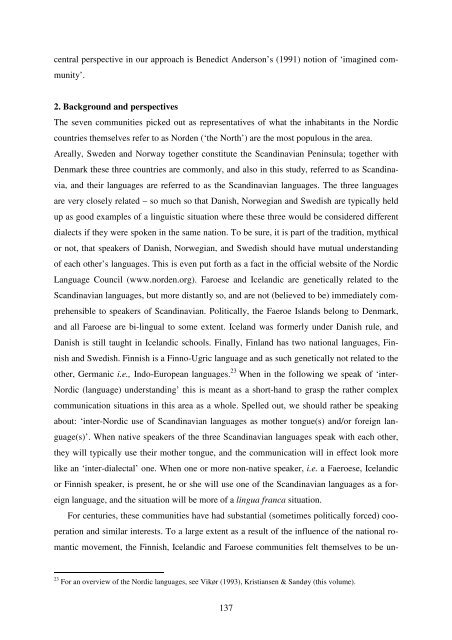Hør dog hvad de siger - Note-to-Self: Trials & Errors
Hør dog hvad de siger - Note-to-Self: Trials & Errors
Hør dog hvad de siger - Note-to-Self: Trials & Errors
You also want an ePaper? Increase the reach of your titles
YUMPU automatically turns print PDFs into web optimized ePapers that Google loves.
central perspective in our approach is Benedict An<strong>de</strong>rson’s (1991) notion of ‘imagined com-<br />
munity’.<br />
2. Background and perspectives<br />
The seven communities picked out as representatives of what the inhabitants in the Nordic<br />
countries themselves refer <strong>to</strong> as Nor<strong>de</strong>n (‘the North’) are the most populous in the area.<br />
Areally, Swe<strong>de</strong>n and Norway <strong>to</strong>gether constitute the Scandinavian Peninsula; <strong>to</strong>gether with<br />
Denmark these three countries are commonly, and also in this study, referred <strong>to</strong> as Scandina-<br />
via, and their languages are referred <strong>to</strong> as the Scandinavian languages. The three languages<br />
are very closely related – so much so that Danish, Norwegian and Swedish are typically held<br />
up as good examples of a linguistic situation where these three would be consi<strong>de</strong>red different<br />
dialects if they were spoken in the same nation. To be sure, it is part of the tradition, mythical<br />
or not, that speakers of Danish, Norwegian, and Swedish should have mutual un<strong>de</strong>rstanding<br />
of each other’s languages. This is even put forth as a fact in the official website of the Nordic<br />
Language Council (www.nor<strong>de</strong>n.org). Faroese and Icelandic are genetically related <strong>to</strong> the<br />
Scandinavian languages, but more distantly so, and are not (believed <strong>to</strong> be) immediately com-<br />
prehensible <strong>to</strong> speakers of Scandinavian. Politically, the Faeroe Islands belong <strong>to</strong> Denmark,<br />
and all Faroese are bi-lingual <strong>to</strong> some extent. Iceland was formerly un<strong>de</strong>r Danish rule, and<br />
Danish is still taught in Icelandic schools. Finally, Finland has two national languages, Fin-<br />
nish and Swedish. Finnish is a Finno-Ugric language and as such genetically not related <strong>to</strong> the<br />
other, Germanic i.e., Indo-European languages. 23 When in the following we speak of ‘inter-<br />
Nordic (language) un<strong>de</strong>rstanding’ this is meant as a short-hand <strong>to</strong> grasp the rather complex<br />
communication situations in this area as a whole. Spelled out, we should rather be speaking<br />
about: ‘inter-Nordic use of Scandinavian languages as mother <strong>to</strong>ngue(s) and/or foreign lan-<br />
guage(s)’. When native speakers of the three Scandinavian languages speak with each other,<br />
they will typically use their mother <strong>to</strong>ngue, and the communication will in effect look more<br />
like an ‘inter-dialectal’ one. When one or more non-native speaker, i.e. a Faeroese, Icelandic<br />
or Finnish speaker, is present, he or she will use one of the Scandinavian languages as a for-<br />
eign language, and the situation will be more of a lingua franca situation.<br />
For centuries, these communities have had substantial (sometimes politically forced) coo-<br />
peration and similar interests. To a large extent as a result of the influence of the national ro-<br />
mantic movement, the Finnish, Icelandic and Faroese communities felt themselves <strong>to</strong> be un-<br />
23 For an overview of the Nordic languages, see Vikør (1993), Kristiansen & Sandøy (this volume).<br />
137



